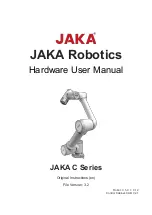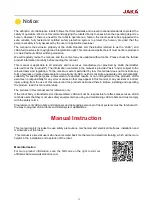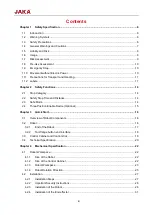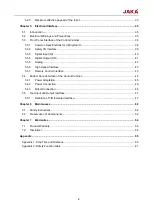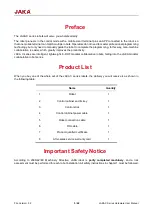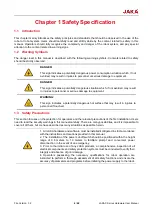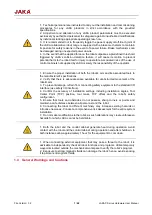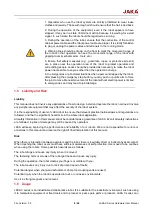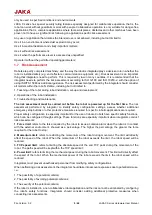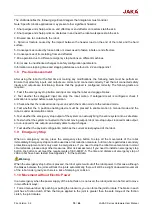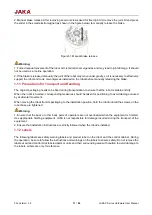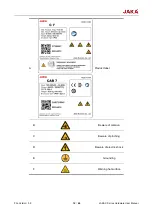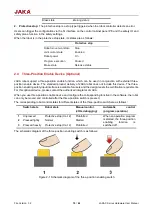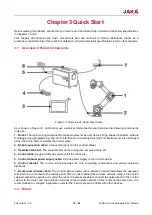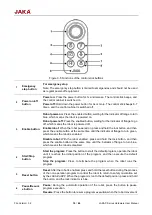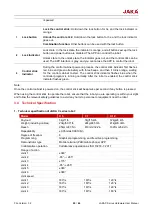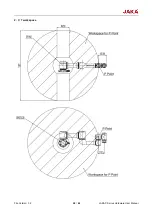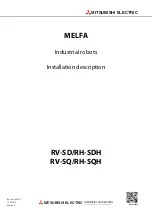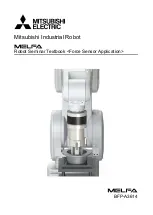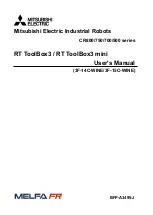
File Version: 3.2
9
/
62
JAKA C Series Hardware User Manual
only be used in specified conditions and environments.
JAKA C series has special security rating features specially designed for collaborative operation, that is, the
robot can work without guardrails or work with people. Collaborative operation is only suitable for danger-free
applications, that is, complete applications where tools, workpieces, obstacles and other machines have been
proven not to have a significant risk following an application-specific risk assessment.
Any use or application that violates the intended use is not allowed, including but not limited to:
Use it in an environment where dust explosion may occur;
Use it in medical treatment and vitally important matters;
Use it without risk assessment;
Use it when the performance level is assessed as unqualified;
Operate it without the permitted operating parameters;
1.7
Risk Assessment
Robots are partly completed machinery, and the way the robot is integrated plays a decisive role in whether the
robot is installed safely (e.g. end effectors, communication equipment, etc.). Risk assessment is an important
thing that integrators need to perform. This is required by law in many countries. It is recommended that the
integrator needs to perform the risk assessment according to ISO 12100 and ISO 10218-2, with the option of
using ISO/TS 15066 as additional guidance. The risk assessment performed by the integrator should consider
all matters within the robot's lifetime, including but not limited to:
1. Teaching of the robot during robot installation, set-up and development;
2. Operations of the robot installation;
3. Troubleshooting and maintenance;
The risk assessment must be carried out before the robot is powered up for the first time.
The risk
assessment performed by integrator to identify safety configuration settings, assess whether additional
emergency stop buttons or other protective measures required for specific robotic applications are required.
Proper safety configuration is especially important for the use of robots. Cobots have specific safety functions,
which can be configured through settings. These functions are especially important when integrators conduct
risk assessments:
1
.
Force limit
: refers to the force required by the robot to issue a collision alarm when the robot is in contact
with the external environment, showed as a percentage. The higher the percentage, the greater the force
required for the robot to stop;
2
.
Momentum limit
: refers to restricting the momentum of the robot during movement. The limit will directly
affect the speed of the robot. When the momentum of the robot exceeds the limit, the robot speed will be
reduced;
3.
TCP speed limit
: refers to limiting the absolute speed of the end TCP point during the movement of the
robot. The path speed will be kept within the TCP speed limit;
4.
Power limit
: refers to limiting the mechanical power during the robot movement. This limit will directly affect
the speed of the robot. When the mechanical power of the robot exceeds the limit, the robot speed will be
reduced.
Integrators must prevent unauthorized personnel from modifying safety configurations.
When performing a risk assessment, the integrator should take into account exposures due to potential misuse,
i.e.:
1. The possibility of a potential collision;
2. The possibility of avoiding potential collisions;
3. The severity of the potential collision;
If the robot is installed in a non-collaborative robot application and the risk cannot be eliminated by configuring
the robot's safety functions. Integrators should consider adding additional protective measures when
conducting risk assessments.

